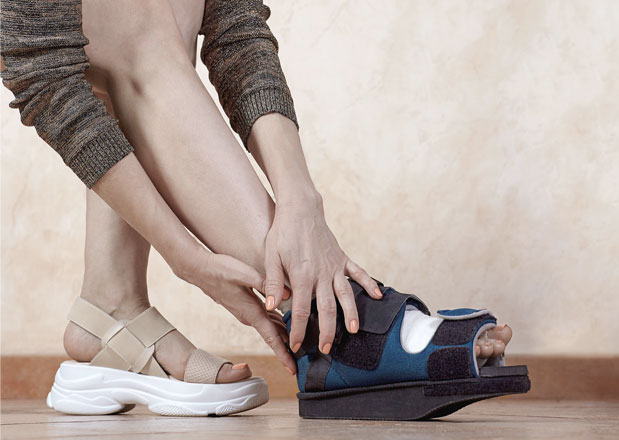Medically reviewed by Paulina Piekarska, D.P.M. A.A.C.F.A.S.
Recovering from bunionectomy surgery requires time and proper care to ensure optimal healing. Here are some top tips to help you during your recovery:
1. Follow post-operative instructions: Strictly adhere to the instructions provided to you by your surgeon or healthcare provider. This includes guidelines on wound care, dressing changes, weight-bearing restrictions, and medication usage.
2. Elevate your foot: Elevating your foot above the level of your heart helps to reduce swelling and promotes blood circulation. Aim to keep your foot elevated as much as possible, especially during the first few days after surgery.
3. Ice therapy: Applying ice packs or the use of an ice machine, on the surgical area for 15-20 minutes at a time, several times a day, can help reduce swelling and manage pain. Be sure to use a thin cloth or towel as a barrier between the ice pack/machine and your skin to avoid frostbite.
4. Pain management: Take prescribed pain medications as directed by your healthcare provider to manage post-operative pain. If allowed, over-the-counter pain relievers like acetaminophen or non-steroidal anti-inflammatory drugs (NSAIDs) can also be used, following the recommended dosage and consulting with your doctor.
5. Wear proper footwear: Your surgeon will provide recommendations for appropriate footwear during the recovery period. It is essential to wear comfortable, roomy shoes or sandals that accommodate any dressings or surgical bandages. Avoid tight-fitting or restrictive shoes that could impede healing or cause discomfort.
6. Practice gentle foot exercises: Engage in the recommended foot exercises and mobility exercises provided by your physical therapist or healthcare provider. These exercises promote circulation, prevent stiffness and aid in the recovery of normal foot function.
7. Gradual weight-bearing and mobility: Follow your orthopedic surgeon’s instructions regarding weight-bearing restrictions and the use of crutches, walkers, or other assistive devices. Gradually increase weight-bearing and mobility as permitted by your healthcare professional to avoid strain or injury.
8. Attend physical therapy sessions: If prescribed by your orthopedic surgeon, attend regular physical therapy sessions. Physical therapists can guide you through appropriate exercises, assist with rehabilitation, and monitor your progress.
9. Maintain a healthy lifestyle: Follow a nutritious diet, stay hydrated, and avoid smoking or excessive alcohol consumption, as these factors can impede the healing process.
10. Communicate with your healthcare provider: Stay in contact with your orthopedic surgeon or healthcare provider throughout your recovery. Report any concerning symptoms, such as increased pain, excessive swelling, redness, or signs of infection.
What is the recovery time for a bunionectomy?
The recovery time for a bunionectomy can vary depending on several factors, including the specific surgical technique used, the severity of the bunion, individual healing abilities, and adherence to post-operative care instructions. Generally, it takes several weeks to a few months to fully recover from a bunionectomy. Here is a general guideline for the recovery process:
Immediate postoperative period (1st week)
- You may need to keep your foot elevated to minimize swelling.
- Pain and discomfort are common, and prescribed pain medications are typically used during this time
- The surgical site is usually protected with a bandage or surgical shoe.
First two weeks:
- Limited weight-bearing or non-weight-bearing is often advised initially, using crutches, or other assistive devices.
- You may have a follow-up appointment to check the incision site and remove any stitches or sutures.
- Swelling and bruising will likely still be present.
Weeks 2-6:
- Gradual transition to weight-bearing, as guided by your orthopedic surgeon.
- Physical therapy exercises may be introduced to improve range of motion, strength, and flexibility.
- Swelling and bruising should start to decrease during this period.
Weeks 6-12:
- Continued physical therapy exercises to further strengthen the foot and improve mobility.
- Most individuals can gradually return to wearing regular shoes during this time.
- Some residual swelling may persist.
Three to six months:
- By this stage, most individuals have significantly improved mobility and are able to engage in more activities.
- Full recovery and return to normal activities can vary, but it is expected within this timeframe.
Remember, every individual’s recovery process may vary, so it’s essential to consult with your orthopedic surgeon or healthcare provider for personalized advice and guidance throughout your bunionectomy recovery.




















